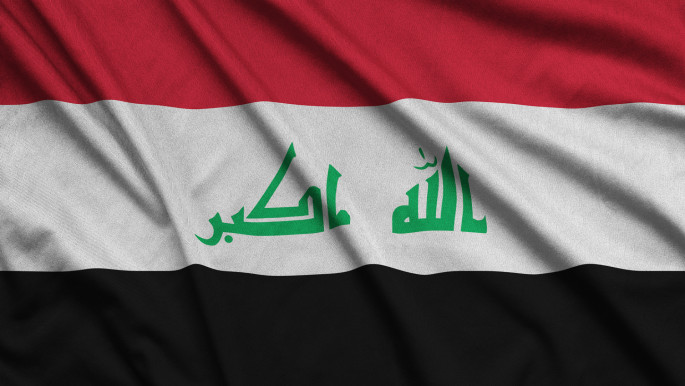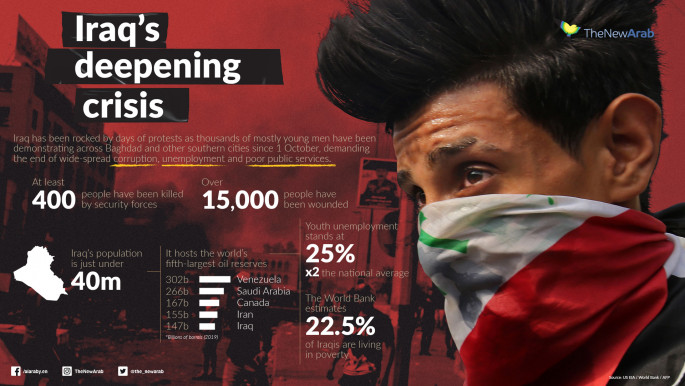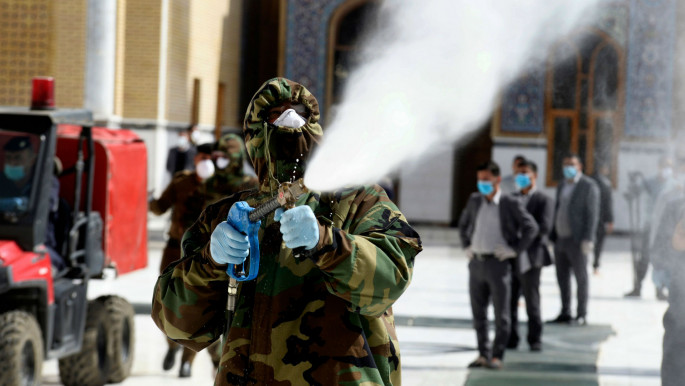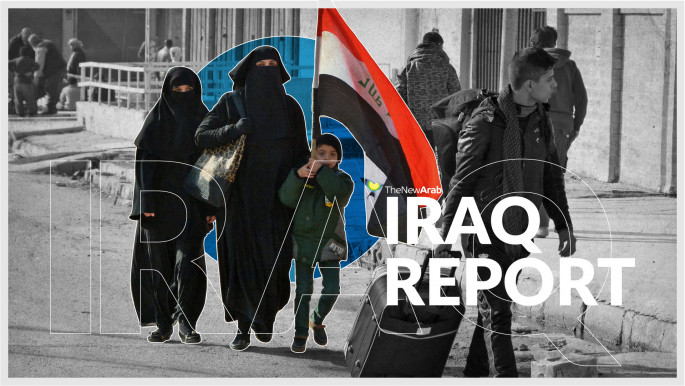The Iraq Report: Iraq still in chaos 17 years after US invasion
Iraq's political system has been fraught with instability and has incubated almost two decades of corruption leading to several protest movements and the rise of violent Islamist militant groups, including many Shia militias who operate as part of the state security apparatus.
The Islamic State group was also born out of the sectarianism and violence that has been emblematic of the Iraqi political process since 2003, which has seen a succession of weak governments and a legislature divided along sectarian quotas.
Today's protest movement - ongoing since October of last year - has aimed to disrupt the cycle of corrupt political appointments, nepotism, and political actors who are beholden to both Iran and the United States.
With the appointment of the second prime minister-designate in as many months, Iraq is now facing an unprecedented political crisis that has been exacerbated by the global coronavirus pandemic.
Iraq still in chaos 17 years post-invasion
Under former President George W. Bush, the United States led a "coalition of the willing" – including the United Kingdom led by then-Prime Minister Tony Blair – into war against Iraq in 2003.
 |
|
| Read more: Baghdad's four decades of conflict and strife |
The invasion led to the destruction of the regime of former dictator Saddam Hussein and the installation of a Western-sponsored governing council that eventually made way for elections to set up a nominally democratic government.
The invasion itself did not come without a great price being paid, primarily by the Iraqi people. According to the Lancet, which published the results of a study on fatalities in 2006, more than 650,000 Iraqis lost their lives up until the time of the study. ORB International, a London-based polling agency, put the figure at 1.2 million people in 2007, although ORB's figures have since been discounted.
Nevertheless, if more than half a million Iraqis died in the three years following the invasion, it is not implausible that in the subsequent years leading to the US' first withdrawal in 2011 hundreds of thousands of others were similarly killed or died as a result of secondary factors related to the war, such as a dearth in medical supplies and the activities of sectarian Shia death squads who played an enormous role in violence in Iraq alongside groups like Al-Qaeda between 2006 and 2008.
With the advent of the Islamic State (IS) group, Iraq was once again hurled into violence that saw the Iraqi military routed by the jihadists and the return of US forces in 2014, this time leading an anti-IS coalition. The coalition not only provided airpower to the Iraqi military, but also to Iran-backed Shia militants who had come together under the Popular Mobilisation Forces (PMF) after a fatwa from Shia Islam's highest spiritual authority Grand Ayatollah Ali Sistani.
 |
The ill-fated US-led invasion of Iraq led to the reported deaths of millions of Iraqis, the destruction of much of the country's infrastructure, and the establishment of an unstable democratic system |  |
The defeat of IS in 2016 did not lead to the withdrawal of American and allied troops, but a flare up affecting relations between Iran and the US on the subject of Tehran's nuclear and ballistic missile programme affected domestic Iraqi affairs greatly.
While nominally independent, the Iraqi authorities have been influenced by both the United States and Iran, particularly the latter, and the PMF were formally recognised as a formal branch of the Iraqi armed forces in the same year IS was defeated.
Read more: The Iraq Report: Iran's power in Iraq now questioned after US kills Soleimani
The tensions between Tehran and Washington resulted in tit-for-tat attacks on bases housing US troops by PMF-linked Shia fighters, and the barracks and depots of PMF fighters targeted by US airpower. These attacks ultimately lead to the assassination of Iranian Islamic Revolutionary Guard Corps Quds Force commander, Major General Qasem Soleimani, in Iraq earlier this year by way of an American drone strike.
With the Iraqi government incapable of defying either the US government or the Iranian regime, and in light of almost two decades of corruption that had reduced living standards and eroded human rights in Iraq, the Iraqi people erupted into nationwide protests in October last year.
The demonstrators have called for the collapse of the political process, free and fair elections comprised of candidates who are not connected to the existing order, and for officials embroiled in allegations of corruption and human rights abuses to be held to account.
 |
Iraq's political system has been fraught with instability and has incubated almost two decades of corruption, leading to several protest movements and the rise of violent Islamist militant groups, including many Shia militias |  |
While powerless to stop the United States and Iran, the Iraqi government and allied pro-Iran militias have shown that they are willing to exercise violent power to suppress the Iraqi protests, killing more than 700 protesters in the span of five months. The demonstrators have shown remarkable resilience, however, and protests continue unabated, even given the advent of the COVID-19 coronavirus pandemic.
As events in Iraq continue to be largely influenced by both Iran and the US, it remains to be seen what long-term impact this protest movement will have on the course the country will chart in the coming months and years.
However, it is certainly seen as a serious threat to the existence of the current political system, particularly as the majority of protesters are from the Shia Arab demographic who are traditionally the voter base most of the dominant Shia Islamist parties draw their electoral wins from.
 |
|
| Click to enlarge |
US and Iraqi forces exchange lethal fire
In the midst of all these developments and the viral outbreak in the country, the United States-led coalition has announced that it will be redeploying its troops from some Iraqi bases. The announcement came in the immediate aftermath of yet another rocket attack by Iran-sponsored militants targeting Western forces in Iraq.
Western troops would handover control to Iraqi forces of three bases in Iraq, including Qaim near the Iraq-Syria border, as well as in Qayyarah and Kirkuk, both in northern Iraq. Hundreds of these troops would be moved to neighbouring Syria, while others would be redeployed to other bases in Iraq or even Kuwait.
 |
|
| Read more: The Iraq Report: An outbreak of virus and violence rocks Iraq |
The move came following a series of rocket attacks orchestrated by pro-Tehran Shia militant groups and retaliatory airstrikes by the US-led coalition that saw a number of combatants on both sides lose their lives.
The attacks began with a barrage of rockets slamming into the Camp Taji base in central Iraq, which led to the deaths of two Americans and one British soldier. Hours after that attack, aircraft believed to belong to the United States attacked Iraqi PMF bases in Syria, killing 26 fighters and wounding dozens more. The US denied responsibility for that attack.
However, Washington claimed responsibility for a retaliation that took place in Iraq itself that targeted arms dumps and supplies depots belonging to Kataib Hezbollah, a faction within the PMF. The attack killed six Iraqis, including one civilian.
The coalition's retaliations led to grumblings of vengeance from the Iran-backed but Iraq-sanctioned Shia militants and, true enough to their word, elements from the PMF again launched a rocket barrage at Camp Taji just north of the capital Baghdad. A third attack was launched on the Besmaya base south of Baghdad, bringing the grand total to three attacks inside a week against US-led forces.
The back-and-forth violence between the US military and the PMF technically mean that both the US and Iraq are killing each other's soldiers. As the PMF are a formal branch of the Iraqi armed forces, ratified by a parliamentary bill in 2016, any attack on them is therefore an attack against the security forces of Iraq.
Nevertheless, the Iraqi government has largely remained silent for a number of reasons, not least of which is the fact that the country has been effectively without a head of government since former Prime Minister Adel Abdul Mahdi resigned late last year as a result of the protest movement.
| |
Since Abdul Mahdi's resignation, two other candidates have been put forward to find some sort of consensus and to form a new government. The first of these was Mohammed Allawi who was nominated as prime minister-designate in February. Before March was out, however, he had resigned due to an inability to form a government and President Barham Salih had named Adnan al-Zurfi, the former governor of Najaf, as his successor.
Zurfi faces a number of problems, including the fact that he is seen by many lawmakers who have close ties to Iran as being too close to the American administration. As the Iraqi parliament is heavily fractured with no one party dominating, this means that he will find it incredibly arduous to build consensus between the different factions.
Another problem he faces is the fact that the Iraqi protest movement sees him as a member of the political elite they wish to hurl out of office, one way or another. He therefore may lack legitimacy in a country whose last elections attracted less than a 45 percent turnout.
With Iraqis more and more showing they have no faith in their country's democracy, and with authorities using ever increasing violence against demonstrators, the lack of a stable government could be a harbinger of even greater chaos to come, 17 years after Iraqis were promised liberty and democracy by the United States.
The Iraq Report is a fortnightly feature at The New Arab.
Click below to see the full archive.
 |
|





 Follow the Middle East's top stories in English at The New Arab on Google News
Follow the Middle East's top stories in English at The New Arab on Google News


